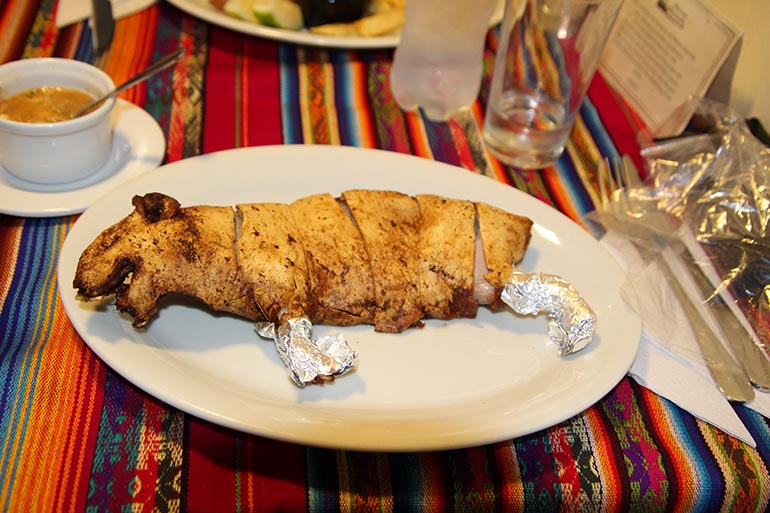Hoangnha Vo: Student Report from 2019 Alternative Spring Break to Ecuador
Mouthwatering at 9,000 ft Above Sea Level
Ecuadorian cuisine is a diverse food culture that takes into consideration its varying elevation levels and different regions. The food is typically rich in carbohydrates and contains a wide variety of fruits, meats, and plants. Dishes range from the simple yet delicious maracuya (red, bitter passion fruit) and tree tomato (which are perfect for smoothies) to a full plate of churrasco (thin grilled steak, fried egg, rice, plantains, chips, avocado, salad) and ceviche (cold seafood soup).
Over the course of spring break, I was fortunate enough to experience the Ecuadorian lifestyle through their diet. Each meal was nutritious, and I certainly felt healthier after each one. On a side note, I highly recommend creating a list of foods you would like to try when travelling to foreign countries. The thrill of being able to mark something off your list and experiencing food from another culture is just sensational.
Lunch at Biloxi
Our first Ecuadorian dish was at Biloxi in the capital city of Quito. I ordered the Seco de Costilla, potato soup, and a glass of lemonade. The Seco de Costilla contained beef, fried plantains, white rice, bibb lettuce, llapingacho, a potato patty, and tomatoes. The restaurant had a cozy urban setting that is welcoming to families and tourists and the food was simply delicious and friendly to foreigners.
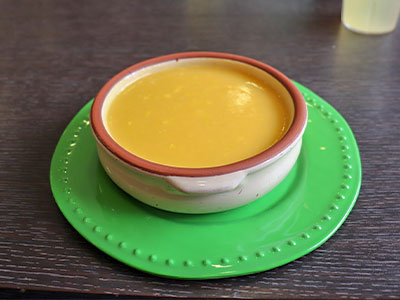
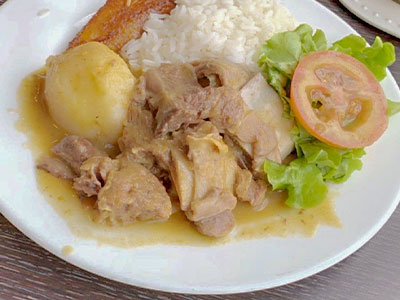
A Cafe Mosaico Dinner
One of our dinners was at Cafe Mosaico, located near the Parque Itchimbia, a park on the side of a hill by the same name with a crystal palace on top. I ordered the El Churrapingacho with a limeade to drink. Similar to Seco de Costilla from the previously-described lunch, the El Churrapingacho was a plate of white rice, fried eggs, lettuce, tomatoes, sausage, llapingacho, avocado, and sautéed beef. From our balcony dining table, we had an amazing view of the brightly lit Quito under the night sky.
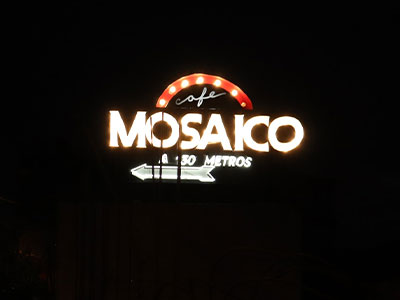
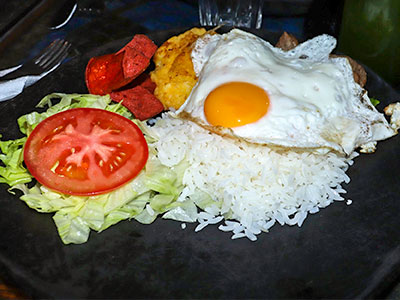
A Typical Lunch in the San Clemente Community
For our lunches at the community house in San Clemente, our host mother graciously prepared for us delicious meals without fail. For both lunch and dinner, we typically had a potato soup base with avocado, dried corn kernels, and salsa as an appetizer. Main entrées included pasta with beef meatballs and a small salad made of lentils and corn. On another day, we had pork chops with corn on the cob and cheesy steamed potatoes. Each meal included different types of fresh juice, such as mora (blackberry), piña (pineapple), and naranja (orange). For a majority of our meals, the dessert consisted of marinated fruit, such as pears, babaco (a type of mountain papaya), peaches, and tree tomato soaked in syrup.
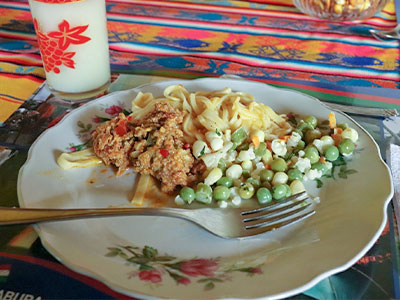
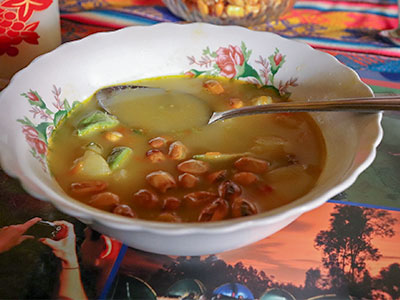
A Special Equinox Lunch
Fortunately for us, we just happened to have our spring break align with the Vernal Equinox, which this year occurred on March 20, 2019. Our host family held a ritual ceremony before we began eating the marvelous feast they had prepared, as this is a significant holiday for them. Various dishes such as chicken fried rice, spinach, salad, lentil and corn, sautéed beef, red beets, and plantains were set around the table. I am proud to say that we sent the huge wooden bowl of fried rice back into the kitchen completely empty and wiped clean, something I played a big role in achieving. We had guayabana (soursop) and tree tomato juice to accompany our fabulous meal. For dessert, we had a special guayabana and mora sorbet which was delicious to say the least.
A Special Dinner by the Students
During our last night in San Clemente, we received an impromptu cooking lesson from our host and his mother. We helped prepare crème soup, fried tilapia, salad, plantain chips, and potato balls. Unfortunately for us, the power had gone out in the middle of cooking so we were unable to use the blender to finish the mixed vegetables which would have been added to the crème soup for flavor. With candles lit, we gathered around the dining table and enjoyed the meal that we played a role in making. We were grateful to our hosts for teaching us how to make authentic Ecuadorian dishes.
Dinner at Galeria Café Restaurante
After searching for restaurants near our hostel, we found Galeria Café Restaurante, an organic Ecuadorian cuisine restaurant, which was just outside of an art gallery. I ordered the ceviche “Galapagos style” along with a cup of canelazo (spiced hot cocktail with cinnamon, panela or sugar, and punta or sugar cane extract). The seafood was amazing and the canelazo sweet and not particularly strong. Overall, our meal was delicious and the restaurant setting was very artistic. The location was only a short distance from the square and I would certainly come back here if I were ever in Quito again.
Say Koo-ey!
To end this trip, there was one must-have dish that I was dying to try while I was in Ecuador. We managed to find the dish at a restaurant called Mama Clorinda, which I mistakenly called “Mama Caliente”. While it looks very frightening, cuy (guinea pig) is a popular Ecuadorian delicacy and it was at the top of my list of dishes to try. Under the fried skin was cooked flesh that tasted similar to slimy chicken meat. Since a whole cuy was rather expensive, I only managed to eat half of one. On the side, I had potato soup with potatoes, tomato, boiled egg, and avocado. The meat proportions on the creature was rather small but I am proud to say that I have experienced eating one.
